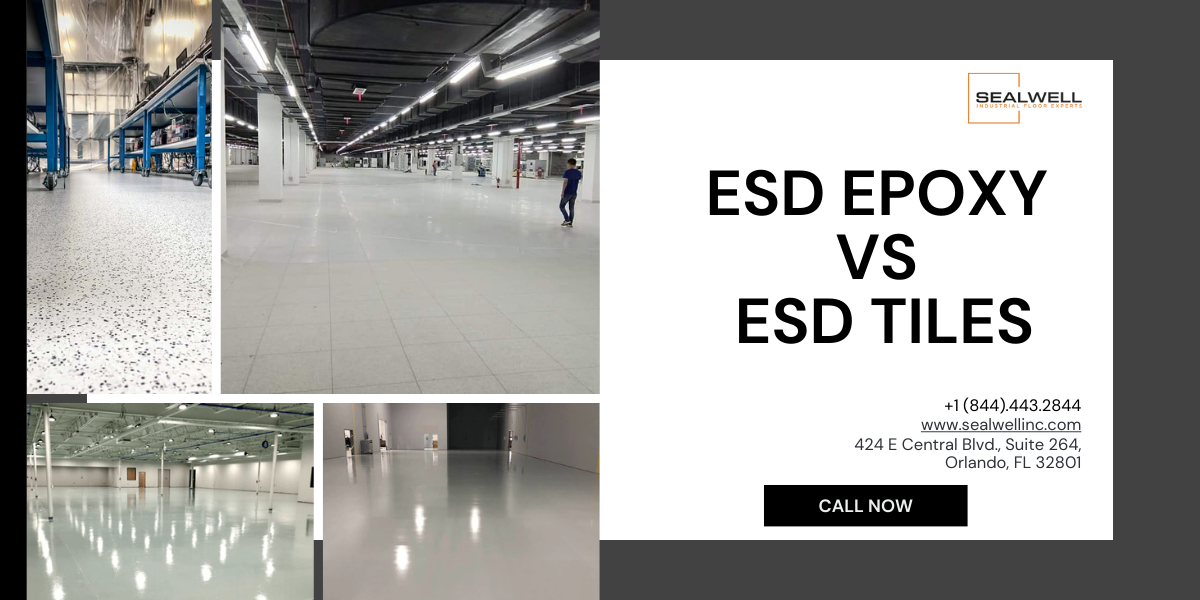Blog and News
ESD Epoxy vs ESD Tiles: Which One is Better?

In industrial environments where sensitive electronic equipment and components are present, electrostatic discharge (ESD) can be a cause of major concern. It is because ESD can cause irreparable damage to delicate electronics which eventually lead to loss of data and costly downtime. Are you wondering how to protect this facility against ESD? The only way to create an ESD-safe business environment is by choosing the right flooring material.
Remember, not every floor coating material is good at protecting the surface from ESD. You should consider the necessary properties to make the most appropriate choice for ESD flooring.
In this blog, we will talk about ESD Epoxy and ESD Tiles. Both being a popular choice for industrial facilities, we will delve into their differences so that you can make the right decision. It will help meet your flooring concerns.
ESD Epoxy
ESD epoxy flooring creates a seamless coating over the existing concrete surface. It is the most preferred option, widely used across several industries, including manufacturing, laboratories, hospitals, etc.
Advantages of applying ESD epoxy floor coating:
Following are some key advantages of epoxy for ESD-safe floors.
- Seamless Surface: ESD epoxy flooring provides a seamless surface, eliminating joints where contaminants can accumulate. It creates a safe, clean, and hygienic environment all around.
- Conductive Additives: The epoxy coating is impregnated with copper and carbon, creating a monolithic, conductive surface. The copper strip conductive elements featured with redundant grounding points act as extra protection for the environment.
- Customization: You can customize epoxy floors meeting the specific aesthetic and functional requirements. You can add amazing colors and use anti-slip additives to enhance safety.
- Chemical Resistance: ESD epoxy flooring is resistant to a wide range of chemicals. It makes the coating suitable for environments exposed to corrosive substances.
- Durability: Epoxy flooring offers extreme durability and a long lifespan. If you are looking for a reliable solution for ESD protection, this can be the best fit.
Disadvantages :
- High cost: Industrial epoxy flooring can be relatively expensive compared to other traditional options. However, this may vary depending on several factors such as customization and additives.
- Need for professional contractors: Here, you need experienced contractors who can perform the necessary steps for safe and effective epoxy flooring installation. From surface preparation to floor assessment, installation, and maintenance, they lay down the floor complying with all industrial standards.
ESD Tiles
ESD tiles, also known as conductive tiles, are modular flooring systems that perfectly fit environments where flexibility and ease of replacement are essential.
Advantages of using ESD tiles flooring:
- Modularity: ESD tiles are assembled and interconnected in a modular fashion. These are designed as individual units connected in a specific pattern to enhance the appearance and functionality of the flooring system.
- Quick Installation: Compared to other flooring options, tiles are easy to install. Their modular design simplifies the installation process, reducing downtime and making the surface more efficient.
- Versatility: ESD tiles appear in different variants. These include vinyl, rubber, and conductive polymers.
Disadvantages:
- Immediate Maintenance Program: After a certain time period, ESD tiles require frequent replacement. It is because modular flooring offers poor abrasion and impact resistance. Over time, it reduces durability, leading to the immediate requirement for perpetual tile replacement.
- Difficult and Expensive to Keep Clean: Unlike seamless flooring solutions, modular tiles floors are difficult to clean as these accumulate dirt in joints. Commercial or industrial facilities have to undergo continuous buffing and waxing maintenance programs to clean the surface and retain its conductive properties. However, the process is too lengthy, difficult, and expensive.
- Poor Quality Control: ESD tiles floors have poor quality control thereby leading to various issues. These involve inconsistent conductivity, non-compliance with standards, inferior static dissipative properties, surface irregularities, poor texture, and so on. Indeed, this compromises the effectiveness and reliability of the flooring system.
ESD Epoxy vs ESD Tiles – Which One to Choose?
Both epoxy and tiles can play a crucial role in anti-static flooring. But considering heavy traffic and the constant movement of heavy machinery, epoxy flooring can be a better choice. From withstanding heavy loads to harsh chemicals, ESD epoxy flooring offers ultimate static electricity protection.
So, are you looking forward to installing the best static-control flooring system for your industrial facility? You can connect with Sealwell, one of the leading industrial flooring experts in Jacksonville, Orlando & Georgia, and share your requirements. We are here to serve you with the most effective flooring solution according to your preferences. Contact us today to get a free consultation and estimate.
Sealwell Inc
Phone No– +1-844-443-2844
Email- in*******@se*********.com
Address- 424 E Central Blvd., Suite 264, Orlando, FL 32801, United States

















































